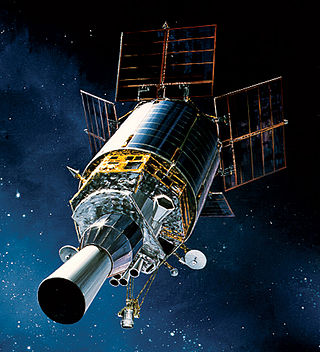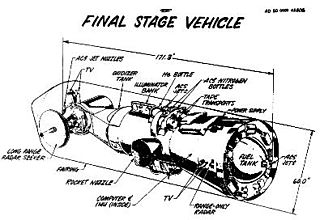
A reconnaissance satellite or intelligence satellite is an Earth observation satellite or communications satellite deployed for military or intelligence applications.
Kosmos is a designation given to many satellites operated by the Soviet Union and subsequently Russia. Kosmos 1, the first spacecraft to be given a Kosmos designation, was launched on 16 March 1962.

Kosmos 954 was a reconnaissance satellite launched by the Soviet Union in 1977. A malfunction prevented safe separation of its onboard nuclear reactor; when the satellite reentered the Earth's atmosphere the following year, it scattered radioactive debris over northern Canada, some of the debris landing in the Great Slave Lake next to Fort Resolution, NWT.

The Lockheed WC-130 is a high-wing, medium-range aircraft used for weather reconnaissance missions by the United States Air Force. The aircraft is a modified version of the C-130 Hercules transport configured with specialized weather instrumentation including a dropsonde deployment/receiver system and crewed by a meteorologist for penetration of tropical cyclones and winter storms to obtain data on movement, size and intensity.

Upravlyaemy Sputnik Aktivnyy, or US-A, also known in the west as Radar Ocean Reconnaissance Satellite or RORSAT, was a series of 33 Soviet reconnaissance satellites. Launched between 1967 and 1988 to monitor NATO and merchant vessels using radar, the satellites were powered by nuclear reactors.

The militarisation of space involves the placement and development of weaponry and military technology in outer space. The early exploration of space in the mid-20th century had, in part, a military motivation, as the United States and the Soviet Union used it as an opportunity to demonstrate ballistic-missile technology and other technologies having the potential for military application. Outer space has since been used as an operating location for military spacecraft such as imaging and communications satellites, and some ballistic missiles pass through outer space during their flight. As of 2018, known deployments of weapons stationed in space include only the Almaz space-station armament and pistols such as the TP-82 Cosmonaut survival pistol.

SAR-Lupe is Germany's first reconnaissance satellite system and is used for military purposes. SAR is an abbreviation for synthetic-aperture radar, and "Lupe" is German for magnifying glass. The SAR-Lupe program consists of five identical (770 kg) satellites, developed by the German aeronautics company OHB-System, which are controlled by a ground station responsible for controlling the system and analysing the retrieved data. A large data archive of images will be kept in a former Cold War bunker belonging to the Kommando Strategische Aufklärung of the Bundeswehr. The total price of the satellites was over 250 million Euro.
Upravlyaemy Sputnik Kontinentalny or US-K is a series of Russian, previously Soviet, satellites used to detect missile launches as part of the Oko system. It consists of a constellation of satellites, usually in molniya orbits, designated under the Kosmos system. The satellites are built by the company NPO Lavochkin and are launched on Molniya-M rockets. Oko can be directly translated as the Russian word for eye. As of June 2014, only two of the eight satellites in orbit were still functional, rendering the system inoperable.

The Missile Defense Alarm System, or MIDAS, was a United States Air Force Air Defense Command system of 12 early-warning satellites that provided limited notice of Soviet intercontinental ballistic missile launches between 1960 and 1966. Originally intended to serve as a complete early-warning system working in conjunction with the Ballistic Missile Early Warning System, cost and reliability concerns limited the project to a research and development role. Three of the system's 12 launches ended in failure, and the remaining nine satellites provided crude infrared early-warning coverage of the Soviet Union until the project was replaced by the Defense Support Program. MiDAS represented one element of the United States's first generation of reconnaissance satellites that also included the Corona and SAMOS series. Though MIDAS failed in its primary role as a system of infrared early-warning satellites, it pioneered the technologies needed in successor systems.
Kosmos 1818 was a nuclear powered Soviet surveillance satellite in the RORSAT program, which monitored NATO vessels using radar. Kosmos 1818 was the first satellite to use the TOPAZ-1 fission reactor. In July 2008, the satellite was damaged, and leaked a trail of sodium coolant.
Kosmos 1867 is a nuclear powered radar ocean reconnaissance satellite (RORSAT) that was launched by the Soviet Union on July 10, 1987. It was put into an orbit of about 800 km (500 mi). Its mission was to monitor the oceans for naval and merchant vessels, and had a mission life of about eleven months.
Kosmos 1402 was a Soviet spy satellite that malfunctioned, resulting in the uncontrolled re-entry of its nuclear reactor and its radioactive uranium fuel. Kosmos 1402 was launched on August 30, 1982, and re-entered the atmosphere on 23 January 1983. The fission reactor entered a few days later; on 7 February 1983.
Kosmos 2440 is a Russian US-KMO missile early warning satellite which was launched in 2008 as part of the Russian Space Forces' Oko programme. The satellite is designed to identify missile launches using infrared telescopes. It spent its two-year operational life at 80E giving early warning coverage of Russia, China, North Korea, the Middle East and some of Europe.
Serpukhov-15 is a military townlet near Kurilovo in Kaluga Oblast which is the location of the western control centre for Russia's Oko satellites. These give early warning of ballistic missile launches, mainly from the continental United States. The site is part of the Main Centre for Missile Attack Warning and information from here is processed at the Russian Aerospace Defence Forces centre in Solnechnogorsk and could be used, together with early warning radar such as the Voronezh, for launch on warning of the A-135 anti-ballistic missile system. A similar facility is located at Pivan-1 in the Russian Far East.

BES-5, also known as Bouk or Buk, was a Soviet thermoelectric generator that was used to power 31 satellites in the US-A (RORSAT) project. The heat source was a uranium 235 fast fission nuclear reactor (FNR).
Kosmos 2421 was a Russian spy satellite launched in 2006, but began fragmenting in early 2008. It also had the Konus-A science payload designed by Ioffe Institute to detect gamma-ray bursts. Three separate fragmentation events produced about 500 pieces of trackable debris. About half of those had already re-entered Earth's atmosphere by the fall of 2008.

An early warning satellite is a satellite designed to rapidly detect ballistic missile launches and thus enable defensive military action. To do this, these satellites use infrared detectors that identify the missile thanks to the heat given off by its engines during the propulsion phase.

Eglin AFB Site C-6 is a United States Space Force radar station which houses the AN/FPS-85 phased array radar, associated computer processing system(s), and radar control equipment. Commencing operations in 1969, the AN/FPS-85 was the first large phased array radar. The entire radar/computer system is located at a receiver/transmitter building and is supported by the site's power plant, fire station, 2 water wells, and other infrastructure for the system. As part of the US Space Force's Space Surveillance Network its mission is to detect and track spacecraft and other manmade objects in Earth orbit for the Combined Space Operations Center satellite catalogue. With a peak radiated power of 32 megawatts the Space Force claims it is the most powerful radar in the world, and can track a basketball-sized object up to 22,000 nautical miles (41,000 km) from Earth.

Project SAINT was a project undertaken by the United States during the Cold War to develop a means of intercepting, inspecting and destroying Soviet spacecraft. Many details relating to the project are still classified. The order to launch the SAINT could only be given by the NORAD commander-in-chief, and presumably, anyone higher ranked than them.

While the United States Space Force gained its independence on 20 December 2019, the history of the United States Space Force can be traced back to the beginnings of the military space program following the conclusion of the Second World War in 1945. Early military space development was begun within the United States Army Air Forces by General Henry H. Arnold, who identified space as a crucial military arena decades before the first spaceflight. Gaining its independence from the Army on 18 September 1947, the United States Air Force began development of military space and ballistic missile programs, while also competing with the United States Army and United States Navy for the space mission.












